Original WW2 US Army 20th Air Force CBI China Burma NCO Uniform USAAF Group
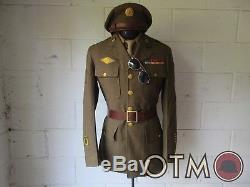
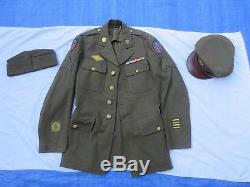
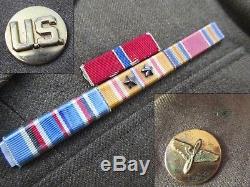
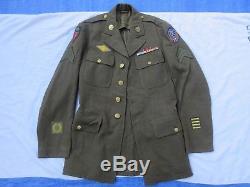
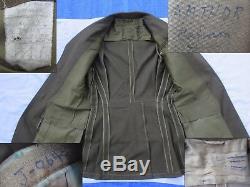

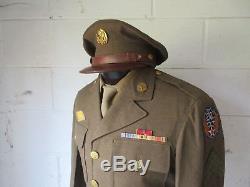
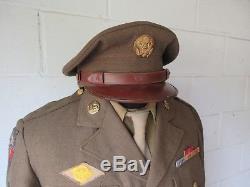
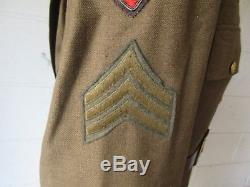
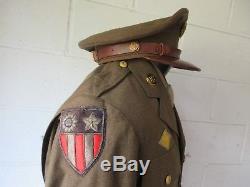

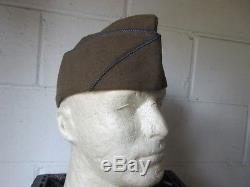


Up for sale is an Original WW2 U. Army (USAAF) 20th Air Force (CBI) "China Burma" NCO Uniform Group - Named Collection w/ Rare Theatre-Made/Bullion Patch Insignia.
A complete list of what you're getting here includes. ONE (1) Original WW2 (USGI) Army/Army Air Forces NCO Dress Uniform Tunic + Insignia dated 1941? ONE (1) Original WW2 (USGI) U. Army/USAAF EM/NCO Dress Uniform Visor Hat. ONE (1) Original WW2 (USGI) USAAF EM/NCO "Garrison/Overseas" OD Side Cap w/ Air Force Piping + Leather Sweatband.
What makes this grouping particularly fascinating is the use of Theatre-Made Sgt. Another interesting trait not uncommon with Enlisted USAAF soldier collections as well as NCO personnel who were often promoted through field upgrades, was to "Crusher-ize" their Visor Hats; in an attempt to mimic the status and feel of the more desirable Bancroft'Flighters', as is the case here with this example.
The difference it presents when compared with the. 8th Army NCO - Tech. We also currently have in stock, the effort and intensity by which he tried to forcibly mold an otherwise static hat without the'Flighters' signature Soft Bill has invariably led to a somewhat delicate weakening in some areas, effectively ensuring this collection should be a carefully displayed showpiece instead of a romp-a-bout play thing for Reenactor fashion sense of Historical Cosplays; however I'm fairly certain that goes without being said. As far as identification to attribute this grouping to a specific soldier goes, as we have to go on at the present is a First + Last Name, and a partial US Military Serial Number. The partial Serial # is written in the Tunic, Side Cap and Visor, but only the name's initials are etched in to the headgear.The full name itself is only written on the inside of the jacket, and the unusual spelling of the Last Name in particular along with the fact that it's in cursive lettering inscribed by hand makes it somewhat difficult to pin down exactly what the surname is. I've provided some of the more probable variations below; also, the First Name is strange as hell but at least that's more legible. Also, just to make clear --if it didn't already come across by the fact that it was completely omitted from the complete list of what you're getting earlier-- the Brown Leather Sam Brown EM/NCO Dress Belt depicted around the uniform, as well as the Wool Service Shirt and Khaki Servicemen's Necktie also depicted in the Cover Photo, are for display/comparative purposes only. They're not actually included in the sale, the shirt and tie belong to that 8th Army Group. I mentioned earlier, I decided just to leave them on for the basic cover shot just to show how nicely this grouping fills out when all the accessories come together.
And besides, the belt I used --because it's the only one we have in stock at this point-- is actually WAY WAY too big of a waistline to match with this slimmer-fitting medium size jacket. In fact, I had to fit a small stack of side caps in the backside between the belt and the back of the tunic just to get the thing to stay on without sliding right of falling straight down on to the floor. I guess being collectors ourselves, I just wanted to see a glimpse of it all fleshed out for myself because it's just looks cool honestly. But what you're ALL getting here is, in its entirety, everything to what it came with. It would be better off in a nice display channeled through someone else instead of hanging up on a clothes rack down in the basement like it's doing right now.
There's just so many groupings we're focusing on right now it's hard to keep up. One in particular is this DAK Cavalry Officer's Theatre-Made Tropical Tunic that held a wad of wartime personal photographs taken by the soldier and his friends in locations in North Africa and elsewhere in the Mediterranean.
Another is a Korean War 45th "Thunderbirds" Division Grouping that's posing a bit of a challenge for me at this point, however, the list goes on. Now when someone uses the word "restore", some people get the jitters and almost go violently comatose muttering things like "put together; put together" so, before those of you who get like this shuffle in to such "a seizure", let me clarify what is meant by saying "restore".
Whatever is there, I leave. If any kind of attributed value can be saved to to reaffirm the historical values that are directly linked to any/all items in the collection, I save.
What more I can manage to accurately salvage in the event of making an. Identification a little less incomplete, I do it. However much can be documented on the case file, I notate it. And whatever may still be missing after fully exhausting all these primary avenues collectively to the raw bone, the main avenues in which I always turn to first, whatever else that's left after that while missing, can be both ethically and responsibly replaced with equally authentic period artifact of equal value to the same one that would have originally been there before.
For instance, a pair of OD Wool Service Uniform Trousers with the corresponding waistline and reasonably approximate height value that's a match is not somehow "undoing", the very fabric of time and space itself, thereby throwing the whole idea that any of it genuinely came together in to ridiculously serious question like its suddenly "all chaos". You think a guy dragged halfway across the world in either one direction or the other, just so they could slug it out to the finish with other poor dumb bastard like his self only doing so, in order to fly back across the world to where they originally came, back to a very different homeland like another world away, with only one pair of pants the whole entire time? Guys went through several often. We've found W2 Army footlockers freshly sprung that have been sealed away since 1946 and the guy had two pairs of pants that were his name and serial #, and another pair that must have been a forgotten loan from a friend, to which, it simply is what it is. You're not altering the awards and unit insignia structure.
You're not turning out a sergeant from what was other a buck private enlisted soldier. You simply filling in the missing holes with what should have been there all along; just like prehistoric archeologists and biologists do when they reconstruct a newly discovered T-Rex Skeleton on exhibit.Many such fossil collections attributed to this breed exist, but less than a handful of them are even 99.9% (which is as close to a "real" 100% as you should ever hope to get) intact. If the same for us is much the same as it is for beast, why would the Antique Archeological everyday people left behind wind up becoming any different? A lot of people don't care, and some people honestly just don't even know. But these elements of apathy and ignorance can breed just as destructive storms as the unforgiving elements equally hostile and indifferent to those fossils in the ground over this ever-increasing period of time. It's gotten to a point where any rescue nowadays, even if it's just fragments of a story, often missing a face but with a name or maybe only part of a serial behind it, just that right there feels like the uncommon victory.
And going back to the "Comparative T-Rex" which got mentioned earlier, and those who work to further study and preserve the traces that were left behind, operate no differently than how we choose to see fit. If part of the left knee cap is entirely missing from the skeletal structure, but another T-Rex Skeletal Collection that's also. To our "Missing a Knee Cap" one from before, than they create a casting that's shaped and made to scale of the Original Example they. Already have, to provide another to the former Dino Group that was simply found missing one.
Such procedures are undertaken and performed in these kinds of situations ALL THE TIME. So if we're all about the science of Facts and Truth here too, again, why wouldn't it be any less different? However, in the case of our "Lost Selections", Genuine USGI Military issues are still available commonly enough that we don't need to provide a synthetic or even semi-synthetic substitute like "Perry Mason in the Case of the T-Rex's Missing Knee Cap". And let's be real here, rustling up a wool shirt, khaki tie, and a pair of pants is no problem compared to this unusual "meat'n' potatoes" that's already going on right here, that's the real focal point to this collection. The rest is a cinch to grab compared with that. Overall a really choice grouping that's certainly much less than ordinary. Much of what I'm recounting is detailed ongoing observations, special considerations, background information, acquisition-related resources, our own experiences upon first coming in to contact with the artifacts themselves, other relevant personal identifications that can be completely unique or even the broader Histories of their Social-Scientific Background in general, faithfully getting retold once more for all the latecomers and those harder of hearing way in the back is the way it's handled, it's ALL getting provided in there.I've been on the receiving end of Bozos that have legitimately voiced serious concern because I've picked up a spare Khaki Necktie that's entirely correct and original but it came from somewhere else so now there's something seriously wrong with it. But then, If I take the tie back off it, now it's not right because "the necktie is missing". Certainly, you must see the majority of other collections similar to our own out there that are way less substantial, some far less reputable, and others that are so more costly even though you're getting less than what it is we're offering you instead. Those some times "dime-a-dozen" alternatives out there don't nearly go as far with it like we do when we get on with it here; we especially know this because we're Collectors of this kind of stuff too. And because of that we want what's right even if the alternative would be more profitable instead, because the honest quality to it, that's where you strike the most gold; we only chase what's real..
Cause anything else would just be less. More Historical Background on the 20th Air Force And The CBI-Theatre.
Formation of the 20th Air Force. The Twentieth Air Force was brought into existence on 4 April 1944 specifically to perform strategic bombardment missions against Japan. This was done at the insistence of General Henry H.
(Hap) Arnold, commander of the USAAF, mainly to avoid having the new B-29 Superfortress being diverted to tactical missions under pressure from the China Burma India Theater commanders. Twentieth Air Force was to be commanded by General Arnold himself at Joint Chiefs of Staff level.Twentieth Air Force was completely autonomous and its B-29s were to be completely independent of other command structures and would be dedicated exclusively against strategic targets in Japan. In addition Twentieth Air Force was chosen (secretly) to be the operational component of the Manhattan Project in 1944, and performed the atomic attacks on Japan in August 1945.
However, in early 1944, the B-29 was not yet operationally ready. The aircraft had been in development at Boeing since the late 1930s and the first XB-29 (41-0002) flew on 21 September 1942. However, the aircraft suffered from an overwhelming number of development issues, and with engine problems (fires). As a result, most of the first production B-29s were still held up at Air Technical Service Command modification centers, awaiting modifications and conversion to full combat readiness. By March 1944, the B-29 modification program had fallen into complete chaos, with absolutely no bombers being considered as combat ready.
The program was seriously hampered by the need to work in the open air in inclement weather, as many hangars were simply too small to house the aircraft indoors; by delays in acquiring the necessary tools and support equipment, and by the USAAF's general lack of experience with the B-29. General Arnold became alarmed at the situation and directed that his assistant, Major General B. Meyer, personally take charge of the entire modification program. The resulting burst of activity that took place between 10 March and 15 April 1944 came to be known as the "Battle of Kansas". Beginning in mid-March, technicians and specialists from the Boeing Wichita and Seattle factories were drafted into the modification centers to work around the clock to get the B-29s ready for combat.
The mechanics often had to work outdoors in freezing weather. As a result of superhuman efforts on the part of all concerned, 150 B-29s had been handed over to the XX Bomber Command by 15 April 1944. In Context of Service in the CBI Theatre. Operation Matterhorn was the name for the B-29 Superfortress offensive against the Empire of Japan from airfields in China. On 10 April 1944, the Joint Chiefs of Staff (JCS) informally approved Operation Matterhorn.The operational vehicle was to be the 58th Bombardment Wing (Very Heavy) of the XX Bomber Command. The headquarters of the XX Bomber Command had been established at Kharagpur India on 28 March 1944. The commander was General Kenneth B. The first B-29 reached its base in India on 2 April 1944. In India, existing airfields at Kharagpur, Chakulia, Piardoba and Dudkhundi had been converted for B-29 use.
All of these bases were located in southern Bengal and were not far from port facilities at Calcutta. The first B-29 bombing raid from India took place on 5 June 1944. Ninety-eight B-29s took off from bases in eastern India to attack the Makasan railroad yards at Bangkok, Thailand. Bombardment operations against Japan were planned to be carried out from bases in China.
There were four sites in the Chengtu area of China that were assigned to the B-29 operationat Kwanghan, Kuinglai, Hsinching, and Pengshan. The primary flaw in the Operation Matterhorn plan was the fact that all the supplies of fuel, bombs, and spares needed to support the forward bases in China had to be flown in from India over the Hump, since Japanese control of the seas around the Chinese coast made seaborne supply of China impossible. By mid-June, enough supplies had been stockpiled at Chinese forward bases to permit the launching of a single attack against targets in Japan. It was a nighttime raid to be carried out on the night of 14/15 June 1944 against the Imperial Iron and Steel Works at Yawata on Kysh.
Unfortunately, the Japanese had been warned of the approaching raid and the city of Yawata was blacked out and haze and/or smoke helped to obscure the target. Only 15 aircraft bombed visually while 32 bombed by radar. Only one bomb actually hit anywhere near the intended target, and the steel industry was essentially untouched.Although very little damage was actually done, the Yawata raid was hailed as a great victory in the American press, since it was the first time since the Doolittle raid of 1942 that American aircraft had hit the Japanese home islands. On the night 1011 August, 56 B-29s staged through British air bases in Ceylon attacked the Plajdoe oil storage facilities at Palembang on Sumatra in Indonesia.
This involved a 4030-mile, 19-hour mission from Ceylon to Sumatra, the longest American air raid of the war. Other B-29s laid mines in the Moesi River. At the same time, a third batch of B-29s attacked targets in Nagasaki.These raids all showed a lack of operational control and inadequate combat techniques, drifting from target to target without a central plan and were largely ineffective. In Washington, it was decided that new leadership was needed for Twentieth Air Force. General Wolfe's replacement was Major General Curtis E. LeMay, who arrived in India on 29 August.
Supply problems and aircraft accidents were still preventing a fully effective concentration of force and effort. In addition, Japanese defensive efforts were becoming more effective. By late 1944, it was becoming apparent that B-29 operations against Japan staged out of bases in China and India were far too expensive in men and materials and would have to be stopped.
In December 1944, the Joint Chiefs of Staff made the decision that Operation Matterhorn would be phased out, and the 58th Bombardment Wing's B-29s would be moved to newly captured bases in the Marianas in the central Pacific. The last raid out of China was flown on 15 January 1945, which was an attack on targets in Formosa (Taiwan). The 58th Bombardment Wing then redeployed to new bases in the Marianas in February.
Crossing Over to the Marianas. The Marianas chain of islands, consisting primarily of Saipan, Tinian, and Guam, were considered as being ideal bases from which to launch B-29 Superfortress operations against Japan. The islands were about 1500 miles from Tokyo, a range which the B-29s could just about manage. The XXI Bombardment Command had been assigned the overall responsibility of the B-29 operations out of the Marianas bases. The first B-29 arrived on Saipan on 12 October 1944.It was piloted by General Hansell himself. By 22 November, over 100 B-29s were on Saipan. The XXI Bomber Command was assigned the task of destroying the aircraft industry of Japan in a series of high-altitude, daylight precision attacks.
The first raid against Japan took place on 24 November 1944. The target was the Nakajima Aircraft Company's Musashi engine plant just outside Tokyo. 111 B-29s took off, Seventeen of them had to abort due to the usual spate of engine failures. The remainder approached the target at altitudes of 2732,000 feet.
For the first time, the B-29 encountered the jet stream, which was a high-speed wind coming out of the west at speeds as high as 200 mph at precisely the altitudes at which the bombers were operating. This caused the bomber formations to be disrupted and made accurate bombing impossible.
Concerned about the relative failure of the B-29 offensive to deal any crippling blows to Japan, General LeMay issued a new directive on 19 February. General LeMay had analyzed the structure of the Japanese economy, which depended heavily on cottage industries housed in cities close to major industrial areas. By destroying these feeder industries, the flow of vital components to the central plants could be slowed, disorganizing production of weapons vital to Japan.
He decided to do this by using incendiary bombs rather than purely high-explosive bombs, which would, it was hoped, cause general conflagrations in large cities like Tokyo or Nagoya, spreading to some of the priority targets. The first raid to use these new techniques was on the night of 910 March against Tokyo. Another wingthe 314th Bombardment Wing (19th, 29th, 39th, and 330th BG) commanded by Brig. Powerhad arrived in the Marianas and was stationed at North Field on Guam.
A total of 302 B-29s participated in the raid, with 279 arriving over the target. The raid was led by special pathfinder crews who marked central aiming points. It lasted for two hours. The raid was a success beyond General LeMay's wildest expectations. The individual fires caused by the bombs joined to create a general conflagration due to strong winds of some 17 to 28 mph (27 to 45 km/h) at ground level, that prevented a more specific firestorm event.
When it was over, sixteen square miles 41 km2. Of the center of Tokyo had gone up in flames and nearly 84,000 people had been killed. The B-29 was finally beginning to have an effect.
By mid-June, most of the larger Japanese cities had been gutted, and LeMay ordered new incendiary raids against 58 smaller Japanese cities. By now, the B-29 raids were essentially unopposed by Japanese fighters. In late June, B-29 crews felt sufficiently confident that they began to drop leaflets warning the population of forthcoming attacks, followed three days later by a raid in which the specified urban area was devastated. By the end of June, the civilian population began to show signs of panic, and the Imperial Cabinet first began to consider negotiating an end to the war. However, at that time, the Japanese military was adamant about continuing on to the bitter end.In June 1945, the XX and XXI Bombardment Commands were grouped under the U. Strategic Air Forces in the Pacific (USASTAF), under the command of General Carl A.
The history of XXI Bomber Command terminated on 16 July 1945. On that date the command was redesignated Headquarters and Headquarters Squadron, Twentieth Air Force. This redesignation brought to an end the XXI Bomber Command as a separate establishment, as it was absorbed into the internal organizational structure of Twentieth Air Force and was placed under the command of USASTAF. ALL Detachable Insignia Includes all FOUR (4) of the "Chest Spaghetti" Awards, including the exotic'Liberation of the Philippines' Medal, which is one of those uncommon ones that often prove among the "lesser seen" variety, TWO (2) EM/NCO Collar Discs which are both Clutchback, and yes, all the clutches are the nice smooth-backing types which, are largely considered to be by many, as the only ones to remain correct in keeping with the idea of only featuring the ones being used back then, at the time during the actual time period so, rest easy now. Other than that, it's all here now. Overall these items are in very good to excellent used condition; exhibiting only minor wear and some natural aging. The collar just above the Flight Disc features a former tear bandaged up by a makeshift field repair.A small portion of stitching on the right-hand side of the Visor bill has come loose, but the damage hasn't spread past the small section that was apparent when we acquired it that way. OTM guarantees these items to be 100% Authentic and Absolutely Original. The item "Original WW2 US Army 20th Air Force CBI China Burma NCO Uniform USAAF Group" is in sale since Sunday, August 12, 2018. This item is in the category "Collectibles\Militaria\WW II (1939-45)\Original Period Items\United States\Uniforms". The seller is "o-townmerch" and is located in Omaha, Nebraska.
This item can be shipped worldwide.
- Special Attributes:: Rare Bullion + Theatre-Made Insignia (Patches)
- Modified Item: No
- Country/Region of Manufacture: United States
- Operational Unit (NAF):: 20th Air Force (20 AF)
- Featured Refinements: U. Army Air Forces (USAAF)


